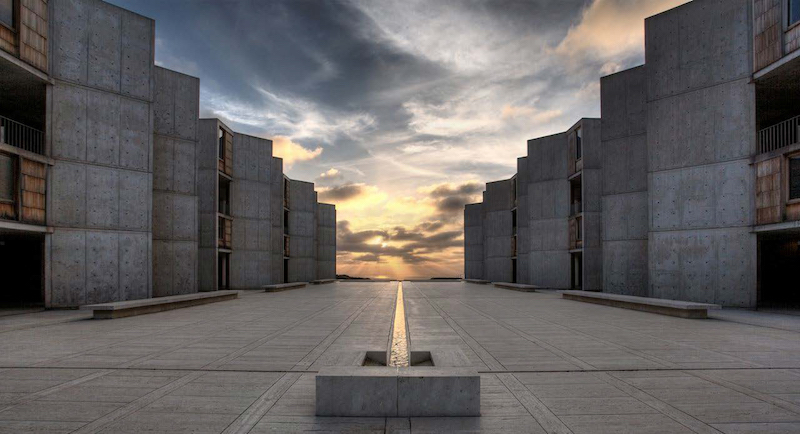After three years of research, the Getty Conservation Institute (GCI) announced construction work is underway to conserve key architectural elements of the Salk Institute for Biological Studies in La Jolla, California. Designed by famed architect Louis Kahn and completed in 1965, the site is widely considered to be a masterpiece of modern architecture.
Dr. Jonas Salk, the developer of the polio vaccine, commissioned Kahn to design the campus for his new scientific research institute on a coastal bluff in La Jolla, just north of San Diego. Kahn worked closely with Salk on the design of the building, which houses laboratories and other research facilities.
But fifty years of exposure in a marine environment has caused the institute’s distinct teak window walls, set within the monolithic concrete walls of the site’s study towers and offices, to weather and deteriorate in a non-uniform manner. The construction work, designed by Wiss, Janney, Elstner Associates, Inc. will address these issues. Getty-led research and funding launched in 2013 as part of the GCI’s Conserving Modern Architecture Initiative (CMAI) helped to initiate the current construction work.
The 203 teak window walls are significant elements of the overall site, expressing a human element and scale within the monumental structure. Although prefabricated, each window has a handcrafted quality due to the detailing of the teak wood by carpenters and customization to fit many sized openings. Each offers a different combination of sliding windows, louvers, and shutters, allowing staff to control light and air in their workspaces.
Research found that the window walls suffered from surface erosion, the growth of a fungal biofilm (likely spread by nearby eucalyptus trees) that gave the wood a black appearance that varied significantly by exposure, changes to teak color due to previously applied sealers and finishes, insect infestation, and moisture infiltration due to the omission of flashings and weather stripping and the failure of sealants.
The GCI and its consultants engaged in historical research, including visits to the Khan archives and collecting oral histories, in order to better understand the significance of the window walls and Kahn’s original vision for the site. It explored the extent of damage to the window walls and performed physical and laboratory analysis to identify materials used and various causes of damage and deterioration. The GCI also convened a meeting of Salk representatives, other Kahn building owners with similar wood conservation issues, and preservation professionals. Possible treatments for the wood and wood replacement options were also researched, as well as design modifications to improve the overall performance of the assemblies. Finally, the GCI, along with the architectural and engineering firm Wiss, Janney, Elstner Associates, Inc. (WJE), which served as the historic preservation consultant to the Salk Institute, developed a series of on-site trial mock-ups to evaluate different repair approaches and treatments to identify the most appropriate ways to move forward.
WJE has developed comprehensive construction documents to implement the repair and conservation of the window walls, with interventions ranging from minor (cleaning and repair), to moderate (cleaning, repair, and some replacement of materials), to major (removal of the entire window assembly where severely deteriorated and replacement using like-for-like materials). At this time, WJE is currently implementing the repair work, which is expected to be completed in 2017.
Related Stories
| May 11, 2012
Chapter 8 High-Performance Reconstruction and Historic Preservation: Conflict and Opportunity
What historic preservationists and energy-performance advocates can learn from each other.
| May 10, 2012
Chapter 7 When Modern Becomes Historic: Preserving the Modernist Building Envelope
This AIA CES Discovery course explores the special reconstruction questions posed by Modern-era buildings.
| May 10, 2012
Chapter 6 Energy Codes + Reconstructed Buildings: 2012 and Beyond
Our experts analyze the next generation of energy and green building codes and how they impact reconstruction.
| May 10, 2012
Chapter 5 LEED-EB and Green Globes CIEB: Rating Sustainable Reconstruction
Certification for existing buildings under these two rating programs has overtaken that for new construction.
| May 10, 2012
Chapter 4 Business Case for High-Performance Reconstructed Buildings
Five reconstruction projects in one city make a bottom-line case for reconstruction across the country.
| May 10, 2012
Chapter 3 How Building Technologies Contribute to Reconstruction Advances
Building Teams are employing a wide variety of components and systems in their reconstruction projects.
| May 9, 2012
Chapter 1 Reconstruction: ‘The 99% Solution’ for Energy Savings in Buildings
As a share of total construction activity reconstruction has been on the rise in the U.S. and Canada in the last few years, which creates a golden opportunity for extensive energy savings.
| May 7, 2012
4 more trends in higher-education facilities
Our series on college buildings continues with a look at new classroom designs, flexible space, collaboration areas, and the evolving role of the university library.
| May 3, 2012
NSF publishes ANSI standard evaluating the sustainability of single ply roofing membranes
New NSF Standard provides manufacturers, specifiers and building industry with verifiable, objective criteria to identify sustainable roofing products.
















